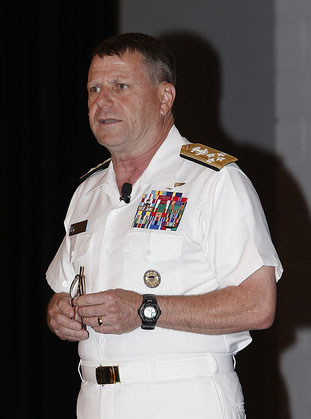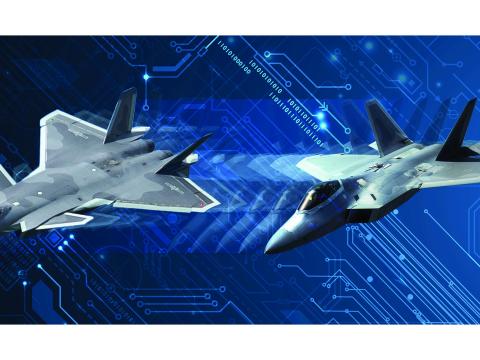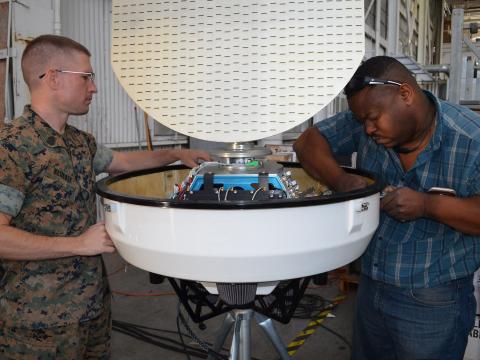Experts Focus on the Effects of Sequestration
East: Joint Warfighting 2013 Online Show Daily, Day 1
Adm. William E. Gortney, USN, commander, U.S. Fleet Forces Command, set the tone for East: Joint Warfighting 2013 taking place at the Virginia Beach Convention Center, Virginia, May 14-16, when he opened the conference by talking about changes and choices in today’s morning keynote address. Although the obvious change is the reduction in financial resources, the other is one that has been mentioned at previous AFCEA International conferences: the shift in focus from Southwest Asia to the entire Pacific region.

Adm. William E. Gortney, USN, commander, U.S. Fleet Forces Command, describes how the military must make tough decisions at East: Joint Warfighting 2013 in Virginia Beach, Virginia.
These changes are forcing choices in both the political/cultural and work force realms. U.S. military leaders must reach out to U.S. politicians to better explain what the services do other than strictly military operations. These leaders also much reach out to the American public, which has been supportive of warfighters during current operations but will need to better understand the need for continued support. In addition, the admiral believes that the U.S. Defense Department budget will increase in the future, but it is important to continue to invest in the work force because when funding grows, it will most likely mean the increase will be because of the need for warfighters to address new threats. “The only way we’re going to get through this [reduction in resources] is to lead our way through it to get to the other side,” Adm. Gortney said.
The admiral’s presentation touched on another topic that continually arose during other presentations: The funding cuts today will have far-reaching effects. Because training and maintenance are two items taking the deepest hits, additional funding will be required in the future to repair the damage. Undoubtedly, making strategic cuts requires tough choices, and the military needs governance to make the right choices, Adm. Gortney stated.
Participants of the first panel of the day discussed how effective command and control (C2) can be provided to operators, and the panelists agreed that technology and the young military leaders who are digital natives are both valuable assets in this arena. However, they must be trained and prepared to operate without the connectivity they are accustomed to because, although the U.S. military has operated relatively uncontested, this is not likely to remain the case. Because adversaries are likely to be more aggressive in denying connectivity, the latest generation of warfighters must continue to learn the traditional means of communications, which is difficult in a time when funds for training have been reduced. “Junior officers rely on computers, so our young people need to be able to do without the technology. We need to set the training to make sure young people understand how to do without technology,” Lt. Gen. William J. Rew, USAF, vice commander, Air Combat Command, said.
Undersecretary of Defense for Acquisition, Technology and Logistics Frank Kendall, today’s luncheon keynote speaker, admitted that the current fiscal situation is “not very pleasant” and the Defense Department did not expect sequestration to occur. Now, the department is doing damage control and the best it can; however, he believes the strategies developed 18 months ago are still good. It is the lack of stability and lack of certainty that are the biggest challenge, Kendall stated.
While the department continues to look at all items to determine efficiencies, supporting current operations and the work force still are priorities. Kendall also believes it is important to continue to invest in research and development even if it is at lower levels. If investments are eliminated today, the effects will reach into the future when it will take more money to start new technologies and the talent of the work force will have moved on. “The little things add up and over time it’s going to cost more later to fix these things. We’re setting up some bills for ourselves that we haven’t been able to take into consideration for fiscal year 2014,” he said.
Members of today’s first afternoon panel continued this theme with Vice Adm. William R. Burke, USN, deputy chief of naval operations for warfare systems, pointing out that furloughs in the shipbuilding field will have a large impact on deployment readiness. Particularly in maintenance, budget cuts now will lead to the need for new ships to replace those that have worn out without proper upgrades. And building new surface ships is a much more expensive proposition than simply keeping current ones in good repair, he said.
Maj. Gen. Karen E. Dyson, USA, director for budget, U.S. Army, stated that her service will experience the same type of issues in the future if equipment and facilities are not fully maintained today. “If we go into fiscal year 2014 with sequestration and a continuing resolution, there will be further degradation,” she said.
While members of today’s final panel veered away from the topic of smaller budgets and their effects, the topic was no less crucial. Representatives from the U.S. military and government discussed the cyber realm and cybersecurity, a topic that has led numerous nightly news programs recently as hacking incidents have increased.
The focus of the discussion was which organization should be responsible for safety and security in cyberspace. While many believe this is a military task, Vice Adm. Herb Browne, USN (Ret.), former vice commander, U.S. Space Command, pointed out that this approach would come with its own set of challenges. Governance, standardization, cybercrime and privacy/civil liberties are not the purview of the Defense Department, which has its hands full with just securing its own networks, Adm. Browne stated.
Vice Adm. Robert C. Parker, USCG, commander, Atlantic Area, and commander, Defense Force East, disagreed with Adm. Browne and said that if the United States is willing to put its people at risk to protect citizens lives, it also should be willing to accept some degree of risk in protecting the networks they have come to rely on.
Terry Halvorsen, chief information officer, Department of the Navy, agreed with Adm. Parker that the United States must be willing to accept some degree of risk, but it must be a calculated risk. But the amount of risk is only one number that must be determined. The U.S. leaders also must decide how much the government should be willing to spend on protecting largely—though important—commercial networks, who or which organization would foot the bill for cybersecurity, and at what point organizations and citizens learn to live with the risk.
The conference continues Wednesday with presentations from Gen. Mieczyslaw Bieniek, Polish Army, deputy supreme allied commander transformation, NATO, and Gen. Robert W. Cone, USA, commanding general, U.S. Army Training and Doctrine Command. Panel discussions will focus on coalition activity, operating in a new environment, and incremental versus radical change.



